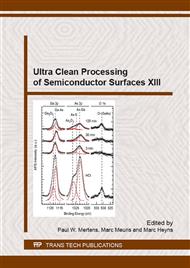p.245
p.251
p.255
p.260
p.265
p.270
p.277
p.285
p.291
Study of TiW Conditioning through Different Wet and Dry Treatments to Promote Ni Electroless Growth
Abstract:
Electroless Ni deposition is often used in presence of Cu, Ti and Au. Recently TiW has also started to be employed, but with this alloy the Ni deposition is not always neat. In our work we investigate the effect of different wet treatments on the Ni growth by means of XPS analyses and SEM inspections. It is found that an oxidized surface inhibits the activator deposition. The de-oxidized Ti atoms in TiW on the other hand are believed to act as the principal sites for Pd seed deposition and subsequent Ni growth.
Info:
Periodical:
Pages:
265-269
Citation:
Online since:
September 2016
Keywords:
Price:
Сopyright:
© 2016 Trans Tech Publications Ltd. All Rights Reserved
Share:
Citation:


